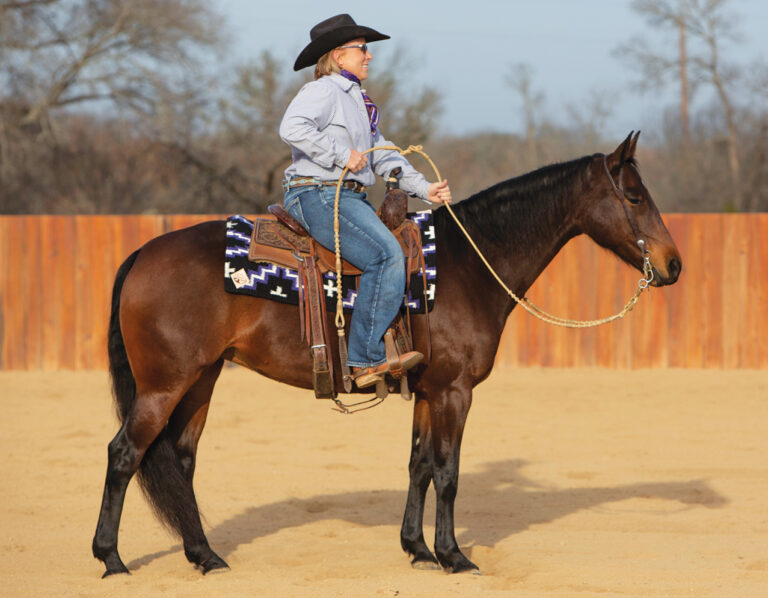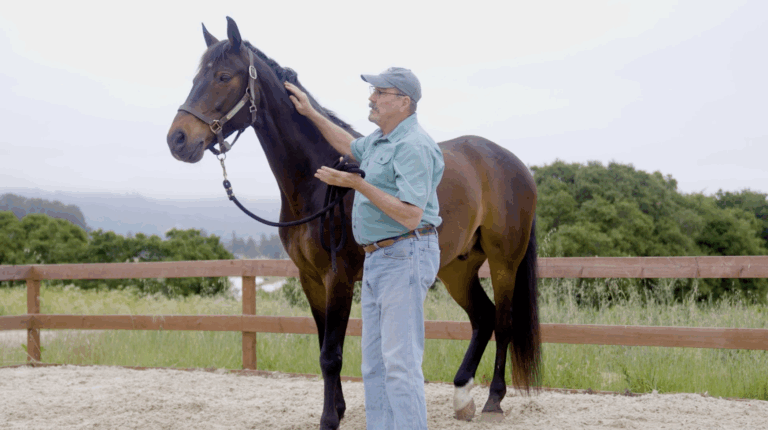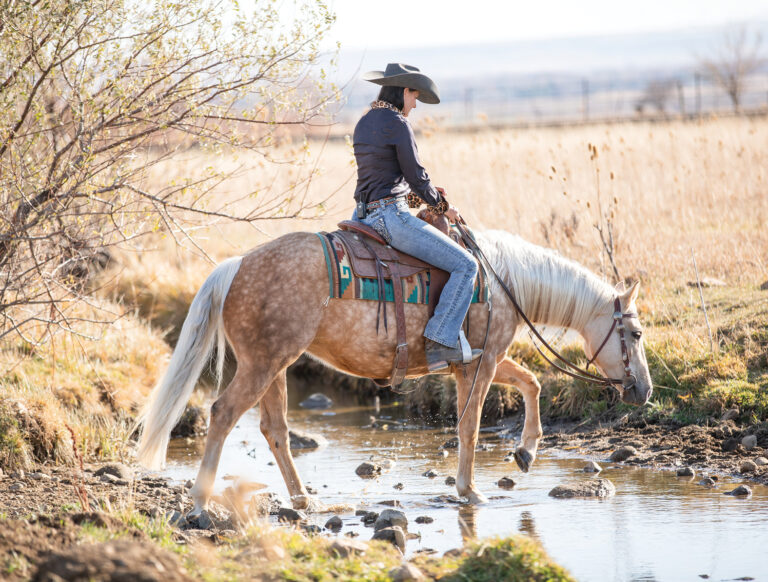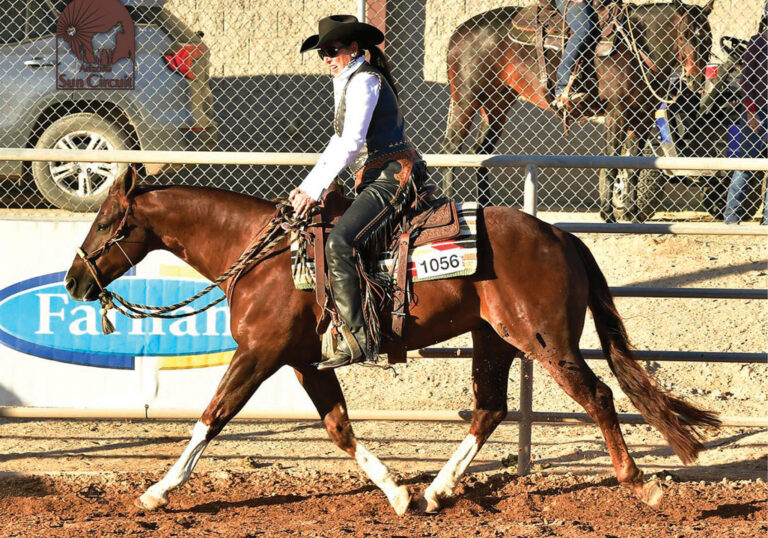[flipbook]
Photos by Jim Bortvedt.
Showmanship at halter, one of the most popular events at all levels of Western showing, tests a handler’s ability to fit and show a horse in halter competition. But no matter how skilled the exhibitor, he or she can’t do well in the class without a horse trained to perform it required maneuvers. If you’re an aspiring competitor wondering just how that’s done, you’ve come to the right place, as it’s what this article is all about.
Regardless of whether your care about showing, though, basic showmanship training offers benefits outside the show ring that every horse owner can appreciate. It improves a horse’s ground manners and increases his respect level for you. It also fine-tunes your ability to control your horse’s position and pace, a skill useful in real-life situations such as backing out of a trailer, turning in tight quarters, even moving a hoof off the hose in the wash rack. At its most developed, showmanship training gives you a level of body control from the ground that can be operated with fingertip finesse.
Who wouldn’t want that degree of handle on a horse? It’s like leading a dance partner instead of lugging a 1,000-pound animal at the end of the rope.
The Foundation
At its core, showmanship consists of six basic maneuvers that are combined in various orders and degrees of difficulty to form a pattern. These basics are leading at a walk, leading at a jog/trot, stopping, backing, setting up for inspection, and pivoting. They form the foundation of showmanship training.
In this article, we’ll demonstrate how to start building this foundation in your horse. Keep these key points in mind as you begin:
- Maneuvers are taught with pressure on the lead chain and pressure from your body position. Immediately reward a correct response with a release of all pressure and a brief pause before you ask for another move or different maneuver.
- All exaggerated body position and verbal cues shown in photos are for training purposes only. Such excessive cues are faults in a judged showmanship class. As your horse progresses in his training, you’ll gradually decrease and refine these cues until they are extremely subtle or non-existent.
- At the beginner training level, progress comes in baby steps. A close approximation to the desired result is considered a correct response. Reward accordingly.
- When your horse reliably responds with a beginner-level effort, request improvement by maintaining or increasing pressure as needed, until your horse responds with a result that’s better than his initial effort. Continue to use the baby-step training method to build toward a solid foundation.
Walking The Walk
Goal: Your horse should lead calmly and willingly, at a pace that matches yours, and with his head and neck in alignment with his body (straight on a straight line).
Starting point: Position your horse so his off-side (his right) is next to a rail, wall, or fence line (see upper-right photo on page 66). This ensures that your horse develops the habit of traveling in proper alignment. Tip: As your horse progresses, gradually wean him away from the rail so he learns to maintain proper alignment on his own.
Position yourself at a point between your horse’s throatlatch and the middle of his neck, facing forward. Tip: You exact position will depend on your size, your horse’s size, and the length of your arms.
Training steps: Keep your hands and arms firm and still as you step off into a brisk walk. Tip: Accentuate your body-language cues for forward motion by slightly inclining your shoulders forward and stepping first with you right foot. This creates a visual cue your horse perceives slightly before the physical cue of chain pressure.
Showmanship training teaches your horse to be as responsive and light on his feet as a dance partner. And that’s useful outside the show arena as well as in! Use our step-by-step instructions for getting started.
Trot Take-Off
Goal: your horse should step smartly into a jog/trot at precisely the same moment you start your run, without changing his basic body alignment.
Starting point: Remain on the rail and in the same position as described in the walk training section. Start forward at a walk.
Training steps: Keep your elbows firmly at your sides, to anchor your lead hand and arms. Tilt your upper body forward as you simultaneously take a huge step forward with your right leg.
Your horse is likely to respond with either of the reactions previously described, although at the faster pace; you can expect the reaction to be more dramatic. Remain calm and continue at a run with your elbows anchored and lead hand steady. The second you horse corrects his pace and position to match yours, he’ll earn his first reward?release of chain pressure. After a few successful strides together at the jog/trot, reward him with a brief, calm walk, then try again. If your horse is extra-reluctant to step into the jog/trot, add a verbal cue such as a “smooch” or “cluck” just before you execute your initial cues.
Whoa Means Whoa
Goal: Your horse should stop in a soft, balanced manner, with his head, neck, and body in proper alignment.
Starting point: Position your horse on the rail and start walking. Tip: When your horse reliably “whoas” at the walk, progress to stopping at a jog/trot.
Training steps: At the walk, say “whoa” in a soft voice and then immediately stop and stand still (saying whoa as a “pre-cue” before you stop gives your horse’s brain time to start processing the stop command). Your horse is likely to drift past you and then stop when the lead chain tightens against his chin. Tip: Don’t pull back on the lead chain when teaching the stop; let your horse discover that his incorrect response, not your hand, initiates the correction.
You’ll know your horse didn’t stop correctly if your position, in relation to his body, has changed?for example, when you stop, you’re standing by his shoulder, instead of at a midpoint between his throatlatch and mid-neck.
If your horse continues to respond lazily to your stop commands, try this correction: Say “whoa” and stop as described above. Then, instead of standing still, immediately start walking backward. At the same time, pull back and down (don’t jerk) on your lead chain and repeat the verbal cue “whoa” with every step you take. Your horse most likely will respond by pushing his head up and resisting moving backward with you. Keep your correction-cue pressure on until your horse lowers his head and takes at least one step backward with you.
When he does, immediately release the chain pressure, then walk forward a few steps and repeat your stop command. You might need to apply this correction a few times while your horse learns to coordinate his body to stop in time with yours. This correction can be used throughout the progression of your showmanship training to sharpen and fine-tune your horse’s “whoa” response. Tip: A few horses tend to stop too rapidly (before you do) when you ask for a stop. You’ll know you have one of these fellows if you find yourself positioned forward at the throatlatch when you stop. Eliminating your verbal pre-cue should fix this problem for you.
Backing Up
Goal: Your horse should readily back up in a smooth, calm manner, with his head and neck in proper alignment with his body.
Starting point: Position your horse on the rail as previously described. From the leading position, turn and face toward the rear of your horse. Align your body so your left shoulder/arm is even with or slightly forward of your horse’s left eye/muzzle. Your right (lead) arm will cross the front of your body to control chain pressure.
Training steps: Grasp the lead shank at the point where the chain meets the leather. Stand up straight and take a large step forward with your left leg as you apply rearward pressure to the lead chain. As you walk forward?”invading” your horse’s space?he should step backward in respect to your body language.
Your horse might move just one leg (likely his left front) out of your way. That’s acceptable for a baby step, so continue to walk forward and apply rearward pressure on the chain to encourage him to move another leg. After a few steps, stop and lead your horse forward and try again. Your horse should show an improvement in his response and respect level by stepping backward simultaneously with both his left front and right hind legs. This is a better response. Continue to build on this progress by consistently applying rearward chain pressure as you step into your horse’s space. Tip: Never position yourself directly in front of your horse. It’s not only a severe fault in a showmanship class, it’s also dangerous.
It’s A Set-Up
Goal: Your horse should set up with his legs positioned squarely underneath him (just as a halter horse sets up), and remain in this position until you cue for another maneuver. Tip: There are several different systems for training the set-up. We describe one here; regardless of the system you choose, do choose a system?there is no training method called ?wiggle until I say ?whoa”
Starting point: At a standstill, turn and face your horse so you’re facing the left side of his head (see upper-right photo on page 68). Grasp the lead shank where the leather meets the chain.
Training steps: Start by establishing individual control over your horse’s feet. Here’s how: To ask your horse to move his left hind leg closer to his right hind leg, either pull straight forward (if the left leg is behind the right) or push straight backward (if the left leg is in front of the right) on the chain until your horse responds by picking up his foot. When he does, immediately release the pressure. Tip: Once you set one foot, say “whoa” before you ask for another foot to move. Otherwise your horse could interpret your continuing chain pressure as a cue to continue moving the foot you’ve just set.
Walk forward a few steps, then stop and ask him to again move the left hind leg closer to the right. You’ll be able to refine his responses as your training continues, because he’ll gradually understand his reward comes when his legs are square. Tip: Work repeatedly on one leg at a time. Once your horse reliably moves his left hind leg in response to your cues, he’s ready to learn to position his front legs. Here’s how: First, set you horse’s left hind leg as close to square as he’s able at this stage and say, “whoa.” Then ask your horse to move his left front leg either forward or backward by first gently pushing his head toward his right. This move rocks his weight over to his right leg, so he’ll be more likely to move his left front leg when you pull forward, or push backward, on the lead chain.
Likewise, to move his right front leg, pull his head toward you, so his weight rocks onto his left front leg, and then direct his right front foot to move forward or backward as needed. Tip: If your horse is reluctant to move a foot and you’ve increased your chain pressure without response, add a soft “cluck’ to encourage movement. This and your “whoa” command should be your only verbal cues to your horse when setting up.
Pivot Power
Goal: Your horse should anchor his right hind foot in one spot, and pivot around that foot by stepping his left front leg in front of and across his right front leg.
Starting point: Face your horse’s left side and position yourself across from his throatlatch. Take your loosely looped lead shank in your left hand and hold the shank where the chain meets the leather.
Training steps: Simultaneously apply light forward pressure to the chain (to encourage your horse to step his left front leg in front of and across his right), take a forward step with your right leg and raise your right hand and lightly tap your horse’s left shoulder. Your horse should yield to your body language and chain cues by moving his shoulder and legs to the right. Ask for only one to two steps to start, so that your horse learns to anchor his right-hind pivot foot while moving his front legs. Gradually add to the number of steps your horse can take before he moves his anchor foot, until he can complete 360-degree pivot correctly.
Beyond The Basics
If your decide showmanship is an event for you, you’ll need to add advanced maneuvers, precision and style to your basic foundation. An excellent primer on competing in the class can be found in AQHA’s Show Rules & Regulations for showmanship at halter (you can access this info on the Web as aqha.com/en/Showing/Content-Pages/Resources/Exhibitors/Handbook.aspx, and then scroll down to section 473).
Other valuable resources include YouTube videos?many exhibitors post videos of their winning performances. Look for AQHA Congress and World Show finalists to emulate. You also can order world-level class DVDs from most breed associations.
Find showmanship pattern to study and practice at horseshowpatterns.com. There’s a small fee for membership to access the patterns.[/flipbook]






